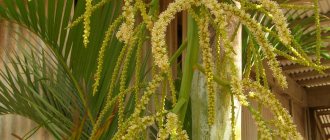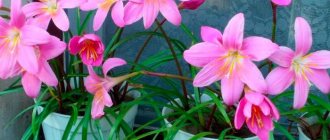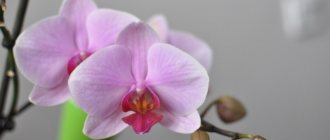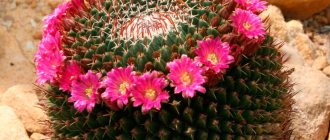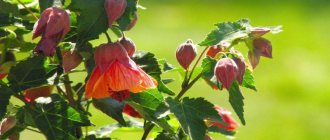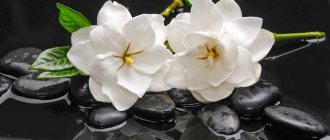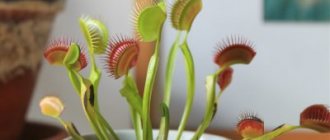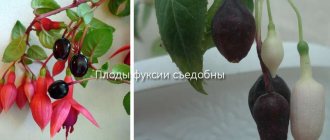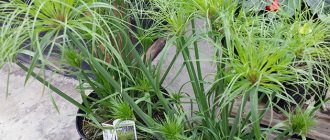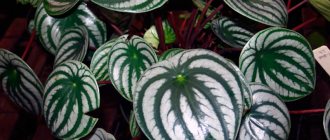Description of Chrysalidocarpus
Chrysalidocarpus belongs to the Palm family, Arecaceae subfamily. Palm trees from this genus are found in multi-stemmed and single-stemmed varieties. The first ones are twisted among themselves or arranged in parallel. The latter have one smooth trunk. They grow up to 9 m tall, but specimens grown indoors do not reach 2 m, develop slowly, by 15-30 cm per year, and rarely produce flowers.
Stems with a smooth or pubescent surface create a lush crown. Some have swollen shoots with lateral shoots. The leaves are pinnate or fan-shaped, deep green in color, with smooth or pointed edges, located at the top of the shoots growing on thin cuttings 50-60 cm long. There are 40-60 pairs of narrow lobes on the branch.
It begins to bloom and bear fruit after 2-3 years with proper care. During flowering (May-June), paniculate inflorescences with yellow flowers appear in the axils of the leaves. Characterized by monocotyledonous and dicotyledonous plants. Chrysalidocarpus seeds are poisonous.
What does chrysalidocarpus look like, what family does it belong to?
Chrysalidocarpus was brought from distant Madagascar; the Comoros Islands are also considered to be its homeland. Belongs to the Arecaceae family, of which there are more than 2.5 thousand species. This palm tree is very moisture-loving, and it tries to extract water not only from the soil, but also from the air.
Chrysalidocarpus areca can grow up to 3 meters
As for the structure, there are plants that look like a bush, since there is strong branching at the base. There are also single-barreled representatives.
In its natural environment, a palm tree can reach 10 meters in height; in a year it grows only 30 cm, but it gains mass in width due to the appearance of lateral shoots.
This is interesting! Many owners of this tropical crop claim that chrysalidocarpus is able to take away negative energy in the house and give out positive energy.
Chrysalidocarpus species
There are more than 160 species of Chrysalidocarpus. Madagascar and Yellowish are grown indoors, the rest are grown outdoors in gardens.
- Madagascar - Dipsis, it has a single straight smooth trunk with a ringed structure, widened at the base. Covered with white bark. Grows up to 9 m outdoors, at home up to 3 m. Pinnate leaves, up to 45 cm long, are arranged in bunches.
- Yellowish or Lutescens - has a bush-like structure, is a thick, dense bush of yellow color, emerging from the roots with young shoots. The leaves are pinnate, up to 60 pairs on an arched two-meter petiole. Reaches a height of 10 m in nature. Grows well in a room up to 3 m.
- Three-stamened - erect leaves growing from the ground in the form of a bunch. Indoors it reaches a height of three meters. On the street up to 20 m. The leaf blades are narrow and elongated. During flowering it emits a pleasant lemon aroma.
- Catechu (Betel Palm) - features a large trunk with long, straight leaves arranged symmetrically and creating a dense crown. In nature, up to 20 m long. In rooms above 3 m. This palm tree is planted in the southern regions to decorate the garden. It blooms and bears fruit rarely.
What is the difference between Chrysalidocarpus and Hamedorea?
Palm trees are mainly distinguished by their appearance. Chrysalidocarpus grows in two forms - as a bush and a single-stemmed palm. The smooth stems are covered with fluff and there is swelling in the places where the rings are located. Lateral shoots may arise from the shoots, forming a group. The ends of the leaf blades are pinnate, dissected at the ends. The color of the leaves is bright green interspersed with small black dots.
Hamedorea has a much larger number of leaf lobes, which droop downward at the ends. The leaf blades are darker and more saturated in color than those of chrysalidocarpus.
The main difference is noticeable during flowering. Hamedorea inflorescences have the appearance of a loose panicle, while areca has yellow inflorescences that are more dense with a frequent arrangement of flowers. The height of Hamedorea is limited to one meter, Chrysalidocarpus - twice as high.
Caring for chrysalidocarpus at home
Growing chrysalidocarpus at home presents some difficulties: you need to create the right lighting, watering, and maintain humidity.
| Options | Spring Summer | Autumn winter |
| Lighting | Bright, diffused. An adult plant can tolerate exposure to direct sunlight. Shade young plants from 11-15 hours. | Place in a sunny place. Use lamps if necessary. |
| Temperature | Optimal +22…+25 °С. | From +16…+18 °С. It is not recommended to place it near cold windows. |
| Humidity | High from 60%. Spray regularly, wash in the shower 2 times a month (in hot weather). Use automatic humidifiers. | 50 %. Do not spray, wipe off dust with a damp cloth. |
| Watering | Abundant, as the soil dries with rainwater. | Moderate, two days after the top layer of soil dries out. Take the water temperature for irrigation 2 °C higher than the air temperature. |
| Fertilizers | From March to October, apply mineral complexes for palm trees twice every 15 days. Take the dosage 10 times less than indicated on the package. | Feed once a month. |
When watering, do not pour water on the stems. Young plants are less stable and may die if treated in this way.
Spider mite
The cause of spider mite damage to chrysalidocarpus is dry air. When a silvery-white web begins to entangle the leaves, there is no doubt that a colony of mites has begun to actively reproduce, and comfortable conditions have been created for it to reproduce. What cannot be said about chrysalidocarpus.
At the initial stage, the conditions of detention and care are changed.
Provide the palm tree with a constant flow of fresh air and give it a warm shower 2 times a week, thereby reducing the parasite population. The acaricidal preparations Apollo and Flumite are also used; at the initial stage, the insecticides Fitoverm or Actellik have a good effect. Attention! It is impossible, in an attempt to kill spider mites, to cover the chrysalidocarpus with a film cap after treatment with drugs. This kills the ticks, but also the palm tree, which may die.
Caring for chrysalidocarpus after purchase
After purchasing, chrysalidocarpus needs to get used to the new climate. The flower should not be replanted immediately; you need to observe it for several days and water it with warm water.
For planting, choose a high pot so that the roots develop freely.
Soil and planting
Replanting is needed when the root system almost breaks the dishes. They do a transfer - take out a lump of earth, shake off the remains from the pot, pour out the drainage, add a new mixture, and plant it in the same container. Large palm trees do not move, they only change the top soil. The time for transplantation is April.
The soil chosen is fertile and light. It should be neutral or slightly acidic, not alkaline. Purchase a ready-made mixture for palm trees. Some gardeners prepare the substrate themselves: two parts each of deciduous humus and clay-turf soil, one part each of humus, peat, coarse river sand, and a little charcoal. For young seedlings, a different composition is selected: 4 parts turf soil, 2 parts peat and humus, one part sand.
Conditions for growing at home
Chrysalidocarpus is an unpretentious plant; even a beginner in the flower business can cope with its care. After purchasing a palm tree, flower growers do not recommend immediately replanting it. It is better to wait with it, give the plant time to adapt to new growing conditions.
We recommend that you learn how to care for bokarneya at home.
Lighting
Since the plant is large, before purchasing, think about where to put it. This tropical flower is accustomed to the sun's rays, so you need to choose a well-lit place for it - near southern or southeastern windows. Direct rays of the sun are dangerous for palm trees. Therefore, it is necessary to take care of protection from them when they directly fall on the flower.
The palm tree requires 12 hours of daylight, so additional lighting will be required in winter.
Important! For uniform growth of the areca crown, it is necessary
to rotate the pot 180
°
.
Temperature
The temperature for palm growth is +22…+25 degrees. In winter - within +16...+23 degrees.
It is important to adhere to the recommended temperatures when growing young plants. Mature palm trees do not react so sharply to short-term decreases or increases in the thermometer.
During the heating season, the flower should be moved away from heating devices and radiators. In the summer season it can be taken out onto the balcony.
Tips for caring for chrysalidocarpus
Choose a light color for the pot to reduce heat in summer. Material – plastic, wood. There is no need to bury the flower when replanting.
Pebbles, pumice, crushed stone, and large perlite are used for drainage. You should not create stagnation of water in the pan; use purified water, melt water, and rain water for irrigation and spraying.
The soil must be regularly loosened and dried shoots and old, yellowed leaves removed. Only dead leaves that are not partially yellowed can be trimmed. Do not damage the barrel.
Ventilate the room, but avoid drafts. Only adult specimens can withstand changes in temperature and lighting. Every ten days, rotate the flower 180 degrees.
How does a palm tree reproduce?
Chrysalidocarpus reproduces in two ways - by seeds and basal shoots. Both of these methods are successful, so you can use either of them.
Propagation by seeds
Chrysalidocarpus lutescens is easy to grow from seeds. They should be sown at the beginning of spring, when daylight hours increase. In order for the planting to be successful and the flowers to germinate, you need to adhere to certain rules:
- The seeds need to be soaked for 3-4 days. Soak them in warm water, the temperature of which reaches about 300.
- The soaked planting material is sown in peat-sandy soil, no deeper than 2 cm.
- The room should have a temperature range of about 20-250, as well as good lighting.
- Sprouts will appear in 3 or 4 months, and when the palm tree has already formed 1 leaf, the flowers need to be planted in separate pots with a diameter of about 12 cm.
Reproduction by root shoots
The plant can be propagated by root shoots all year round, but spring and summer are considered the best option. The shoot is separated from the mother tree using a sharp knife. You need to choose the sprout that has already formed a root. After separation from the mother tree, it is placed in moist soil and cared for in the same way as the mother tree.
Palm tree propagation
Reproduction
Palm trees are propagated by seeds and cuttings.
Seeds
Step-by-step reproduction steps:
- Soak the seed for two days in warm water or for 10 minutes in a sulfuric acid solution to accelerate germination (2-3 drops per 200 g of water).
- Planted in peat, one in each container.
- Make a mini-greenhouse (cover with film).
- The temperature is +25...+30 °C degrees, humidity 70%.
- After germination (two months later) they are planted.
Cuttings
For propagation in spring:
- Cut off young shoots with a sharp knife.
- Remove all leaves.
- The cut of the plant is sprinkled with ash and dried.
- The cuttings are treated with a root former (heteroauxin) and planted in sand.
- Temperature +27…+30 °С.
The roots grow back after three months.
Preparation of planting material and propagation
Dipsis is usually grown from young seedlings, which can be purchased in special nurseries or flower shops. Palm trees are also sold on numerous online resources. But when purchasing through websites, there is a risk of purchasing a sick, weakened specimen, or it may be damaged during transportation.
It is better to choose older palm trees, with a height of 1 m. Such plants have stronger immunity and take root better in new conditions. It is also worth checking the condition of the dipsis. There should be no rot, damage or drying leaves.
You can also get healthy palm trees from seeds. But this process is labor-intensive and takes a lot of time. An adult plant can be propagated by dividing the bush.
Saplings from seeds
Dipsis can be grown from seeds in spring or summer. You will need to maintain a high temperature near the plants. And it is advisable to use a greenhouse with bottom heating in the process. And you should germinate seeds in small containers. Plastic cups will work, but they should have drainage holes.
You will also need to prepare a nutrient substrate. You can use ready-made soil intended for palm trees, but it is better to make the mixture yourself.
To do this, you need to mix leaf humus with perlite and turf soil in a ratio of 2:1:1. Seeds germinate in a moist, but not wet substrate. So it is important to arrange drainage at the bottom of the containers. It is better to use expanded clay for it.
The event should be carried out according to the following algorithm:
- For cultivation, you should choose hard seeds, up to 3 years old. They must be poured with sulfuric acid for 10 minutes and then rinsed thoroughly with water.
- At the bottom of the cups you need to pour a layer of drainage 1 cm thick. Then they need to be filled with nutrient substrate to 2/3 of the volume.
- After moistening the soil, you need to plant the seeds into it to a depth of 2 cm.
- The containers should be covered with transparent film or glass and placed in a bright place. It is also important to maintain the temperature around them within +27…+35 °C.
The substrate must sometimes be sprinkled with water to prevent it from drying out. You also need to ventilate the greenhouse 2 times a day and remove condensation from the film. In such conditions, seeds will germinate within 1.5-2 months.
When the first seedlings appear, they need to be moved to a more shaded place where direct sunlight does not reach. But it is important to maintain the same level of heat near them, as well as regularly moisten the soil and ventilate the greenhouse.
It is also necessary to feed palm trees once a month. And they need to be fertilized with a complex mineral preparation diluted in water (5 g per 10 l). It is worth removing the cover after one leaf is formed on the sprouts. At the same time, the seedlings need to be transplanted into individual pots.
Delenki from an adult palm tree
Dipsis, which can be a bit of a hassle to care for at home, is easily propagated by dividing the bush. But this method is suitable for adult specimens that have several trunks.
It is better to hold this event in April. And you can combine this procedure with plant transplantation. First you need to prepare several pots in which the cuttings will be planted. It is also necessary to purchase a substrate intended for palm trees.
To make your own soil, you need to mix humus with humus, leaf soil and compost (2:1:1:1). It must first be disinfected by calcining it in the oven or heating it over steam. You will also need to prepare drainage (expanded clay, perlite).
It is important to carry out the propagation process quickly so that the roots of the plant do not dry out.
And during the event you will need to follow these instructions:
- Drainage, 3-4 cm thick, should be poured into the bottom of new pots. The layer should be sprinkled with fertile soil.
- The palm tree must be carefully removed from the old flowerpot. If you water the plant well in advance, this will be easier. You can also draw between the walls of the pot and the substrate with the blunt side of a knife.
- Using a wooden stick, the roots of the plant should be freed from the old earthen clod. The culture must be divided and cut into several parts with a sharp and disinfected knife. Each of them must have a sufficient number of roots and stems.
- The divisions should be placed in the center of the pots. Having carefully straightened the roots of the plants, you need to gradually fill them with new substrate. To prevent voids from forming in the soil, you should tap the walls of the pot during the process.
- The substrate needs to be slightly compacted and watered well with warm water.
Plants should be moved to a bright place. It is important not to expose them to direct sunlight. It is also worth protecting palm trees from drafts and maintaining the temperature around them within +20...+25 °C.
It is also advisable to place a humidifier near the divisions. If this is not possible, then you will need to place containers of water near the pots and regularly spray the foliage. Water the soil as it dries.
Under optimal conditions, the divisions will take root within 10-15 days. As soon as their leaves restore turgor, you need to feed the plants with complex mineral fertilizer. But you need to use only half the dose specified by the manufacturer. After 1-2 days, you can put the palm trees in a permanent place.
Mr. Summer Resident advises: possible difficulties when caring for chrysalidocarpus and their solution
If a plant grows poorly or gets sick, it needs fertilizing, a certain watering regime, and proper lighting.
| Problem | Signs | Elimination methods |
| Nitrogen deficiency | The leaves are first light green, then yellow, and the plant stops growing. | Use nitrate (ammonium, sodium), ammophos, urea. |
| Potassium deficiency | Yellow, orange spots on old leaves, necrosis of the edges appears, the leaf dries out. | Feed with potassium sulfate and wood ash. |
| Magnesium deficiency | Light, wide stripes along the edges. | Fertilize with magnesium sulfate and potassium magnesium. |
| Manganese deficiency | New leaves are weak, with necrotic stripes, and small in size. | Use manganese sulfate. |
| Zinc deficiency | Necrotic spots, leaves are weak and small. | Use zinc sulfate or zinc-containing fertilizers. |
| Dry, cold air, insufficient watering | Brown spots on the tips of leaves. | Increase the temperature, humidity, water more abundantly. |
| Too much sun or too little moisture | The leaf blade turns yellow. | Shade, when it is too hot, water more often. |
| Brown leaf spot | Watering with hard water, waterlogging, low temperature. | Adjust watering, temperature according to the season, and settle the water. |
| The lower leaves darken and die | Abundant watering. The leaves were torn off by hand. | Cut the plates with sharp scissors. |
| Brown plate tips | Cold, dry air, lack of moisture. | Raise the temperature, moisten, water more often. |
Install drainage so that water flows into the pan immediately after watering.
To know that it is time to water, pierce the ground with a sushi stick. When it is slightly damp, you can water it; the soil sticks - it’s not time yet.
Difficulties in growing
Improper maintenance conditions and errors in care lead to the plant being affected by diseases and parasites. Some of them can be dealt with using folk methods and special drugs, while some cannot be treated.
Diseases
Most often, chrysalidocarpus is affected by infections caused by fungi. The main symptom is dark spots with a yellow rim on the leaves, the middle of which subsequently dies. Such diseases occur with high humidity and excessive watering. To prevent illnesses, you need to adhere to the recommended frequency of watering and do not overdo it with spraying. Treatment should be carried out with fungicides approved for ornamental foliage plants, for example: “Topaz”, “Hom”, “Skorom”, “Tiovit”.
Pests
- Thrips. The fact that they have settled on the plant is indicated by small holes on the leaves, brown spots, and deformation of the stems. Their reproduction is facilitated by dry air and lack of spraying. The palm tree is treated by spraying with insecticides “Aktellik”, “Inta-Vir”, “Fitoverm”, “Aktara”.
- Spider mite. Appears when the indoor air is too dry. Symptoms of damage include cobwebs on the trunk and leaves. Control is carried out by increasing humidity and spraying with acaricides "Apollo", "Borneo", "Flumite", insecticides "Fitoverm", "Aktellik" and other preparations.
- Nematodes. May affect leaves, stems and roots. When infected with a nematode, a houseplant must be disposed of along with the pot.
- Mealybug. These pests provoke weakening of the flower and stunting of its growth. To prevent damage, you should maintain a normal level of humidity and follow watering schedules, and remove dried leaves in a timely manner. The fight consists of wiping with a soap solution, spraying with a solution of green soap, infusions of garlic, tobacco, and the preparations “Aktara”, “Biotlin”, “Calypso”, “Confidor”, “Fitoverm”.
- Shield. The main symptom is brown spots on the leaves. For treatment, wipe down with a soap-alcohol solution (15 g of liquid soap + 10 ml of denatured alcohol + 1 liter of water), spraying with the preparations “Aktellik”, “Phosbecid”, “Aktara” is used.
Important! When using insecticides and fungicides, you must strictly adhere to the instructions included with the product and observe personal safety measures - protect your eyes, hands, nose and mouth, do not eat, drink or smoke during the procedure.
- Leaves turn yellow and curl. This indicates that the flower is hot or has too much light. It is necessary to change the nature of the lighting to diffused or move the flowerpot to a different location.
- Darkening and drying of leaves is a sign of dry air, moisture deficiency, and exposure to cold. It is necessary to determine the exact cause and eliminate it.
- Brown spots on the leaves are found when the flower is flooded, watered with hard water, when it experiences sudden temperature changes. To correct the situation, watering is normalized and the temperature is controlled.
- The leaves turn black or darken when there is an excess of moisture and the rhizomes rot. Replanting and normalizing the watering regime will help.
Diseases and pests
The plant can be attacked by fungal diseases and pests.
| Disease/Pest | Manifestations | Corrective measures |
| Helminthosporiosis | Dark spots on the leaves, with a yellow rim. | Treat with fungicide (Vitaros, Topaz), do not water often, reduce humidity. |
| Chervets | The pest causes yellowing and damage to the leaves. | Treat with an alcohol swab, then with insecticides (Aktara, Mospilan). |
| Mite | The leaves dry out and have yellow spots on them. | Treat with an acaricidal agent (Anti-mite, Actellik, Envidor). Maintain high humidity. |
Chervetsy
If you notice that the chrysalidocarpus has slowed down, the leaves have shriveled and began to fall off - check, it’s likely that a mealybug has settled, which lives not only on leaf blades and stems, but also in the soil, affecting the roots. The pest is popularly called a hairy louse, since the nests of the pest are similar to lumps of white cotton wool.
In the initial stage, they try to clean the chrysalidocarpus with a brush or cotton swab dipped in a soap or alcohol solution. But it’s better not to wait for the scale of the scale insect to spread, since traditional methods rarely work in this case. Getting rid of scale insects is difficult even when using chemicals.
The mechanical cleaning method is used in conjunction with the chemical one. It is more effective to treat chrysalidocarpus once a week with Aktara, Calypso, Condifor, Mospilan, etc. Proceed strictly according to the instructions, without trying to reduce the dosage, as it will not be possible to achieve a therapeutic effect. If the dosage is exceeded, chrysalidocarpus leaves burn.
Rules of care
The areca palm is a tropical and whimsical plant. To grow a truly high-quality and healthy specimen, you will have to try and make an effort.
Temperature and humidity
Adult palms that are at least 10 years old are considered more cold-resistant. They can withstand temperatures down to 5 -6 degrees below zero. But the leaves themselves retain a healthy appearance only when the thermometer drops to 0 degrees for a short period of time.
If the room is cold for a long time, the palm tree begins to ache, wither, and then may die. Don't forget that this is a guest from the tropical forests. The soil temperature should be at least +20 - 27 degrees, and the air should warm up to +37.
The tropical beauty likes the room to have a high level of humidity. Although he feels good under normal conditions. But if the air is very dry, the leaves begin to dry out at the tips. The palm tree loses its bright color and splendor.
Soil composition
It is important that the soil drains water well and is loose. The areca palm is one of the few plants that loves highly acidic soil; in extreme cases, it should be neutral - 6 - 7.8 pH
A layer of drainage must be made at the bottom of the pot, which allows the water to pass through the roots very quickly without stopping. For the drainage layer, gravel, granite, coarse sand, peat, and pebbles are used. It is better to choose large factions. Clay soil and fine river sand are not suitable due to the presence of small particles.
For planting or transplanting, you can use a specially selected substrate for palm trees. But many gardeners make up their own soil mixture in order to know exactly what components are included. You will need:
- 1 share of pine bark (fractions from 20 mm);
- 1 share of pumice (slag - as an alternative);
- 2 shares of peat (rough);
- 1 share of pebbles, dolomite crushed stone (fraction 12 mm);
- 1 share of perlite;
- 1 share of charcoal (fraction 10 mm);
- 0.1 shares of bone meal.
All ingredients must be thoroughly mixed until smooth. Ingredients that do not maintain a firm and dense structure are not used. They will cake and have poor moisture permeability, which will lead to putrefactive processes in the root system. Experienced plant growers recommend using perlite and pumice in their pure form to make the soil healthier.
What is perlite?
This is glass that comes from volcanic rock. In soil it serves as a loosening agent. Its huge advantage is that it does not cake or compact, and is perfectly permeable to water and moisture. It is an environmentally friendly natural material and mineral. Does not have any nutrients, does not contain organic matter. Fractions from 2.3 to 5 mm.
What is pumice?
It is also a product of volcanic activity. Can be found in many parts of the world, but the best quality is in Iceland. Used in the substrate to improve the conductivity of moisture and air. It is better to combine with coconut fiber, then the air-conducting and moisture-conducting properties are improved. Can be used in its pure form as a drainage layer.
You should purchase special fertilizers for palm trees, which contain all the necessary nutrients in the right ratio. It is recommended to apply them throughout the year.
In spring and summer, fertilizers are applied once every 14 days. In the autumn-winter period no more than once every 30 days.
